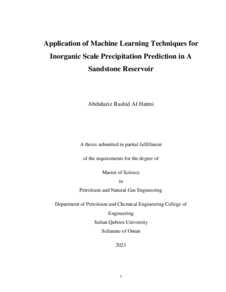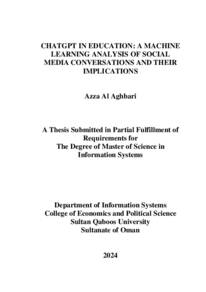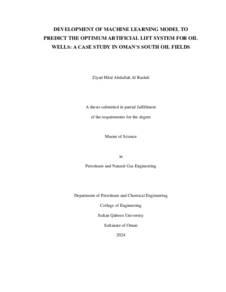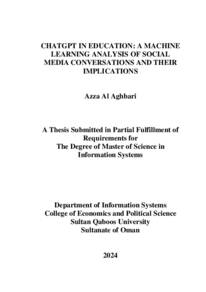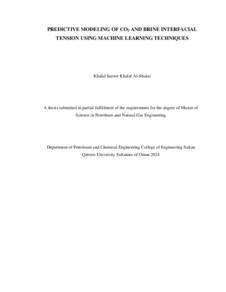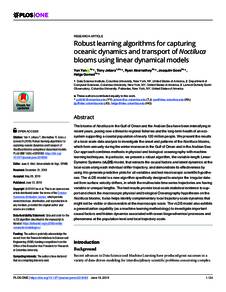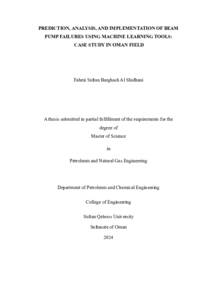Document
Application of machine learning techniques for inorganic scale precipitation prediction in a sandstone reservoir.
Source
Master's thesis
Other titles
تطبيق تقنيات التعلم الآلي على تنبؤ ترسيب الحجر اللاعضوي في خزان الصخور الرملية
Country
Oman
City
Muscat
Publisher
Sultan Qaboos University
Gregorian
2023
Language
English
Subject
Thesis Type
Master's thesis
English abstract
In the realm of the oil and gas industry, the emergence of inorganic scale formations has
emerged as a significant concern, profoundly affecting flow assurance and the overall
efficiency of oil and gas fields. These precipitates, with their potential to inflict damage
on reservoirs, well completions, and surface facilities, present formidable challenges to
petroleum engineers, production specialists, and facility managers alike. Despite the
existence of numerous commercial computer applications designed to forecast inorganic
scale formations with a degree of precision, a major drawback lies in their inherent
limitations, which can detrimentally affect the accuracy and efficacy of these predictions.
In recent years, there has been a considerable surge in the application of machine learning
(ML) within the oil and gas sector. This study aims to delve into the utilization of machine
learning algorithms as a fresh and innovative avenue for predicting the occurrence of
inorganic scale precipitations specifically within carbonate formations in the oil and gas
industry.
The methodology employed in this present study revolves around the collection of both
input and output data. This dataset encompasses a wide array of variables including
pressure, temperature, artificial lifting method, target formation, water ionic composition,
water cut, pH levels, total dissolved solids (TDS), and the propensity of each well to
precipitate inorganic scale. For the purpose of prediction, a selection of machine learning
algorithms has been made. These include Naive Bayes (NA), Neural Network classifier
(NN), Logistic Regression (LR), Random Forest (RF), Decision Tree (DT), Support
Vector Machine (SVM), and K-Nearest Neighbors (KNN). The evaluation of these
algorithms will be primarily based on metrics related to accuracy and other pertinent
classification performance indicators.
The outcomes of the model evaluations demonstrate that Gaussian Naive Bayes, Logistic
Regression, and Neural Network emerge as the most proficient classifiers regarding
prediction accuracy, boasting an impressive score of approximately 90%.
The adoption of the suggested model promises numerous advantages. This includes the
efficient allocation of well intervention resources, mitigated oil deferment arising from
pump failures attributed to scale precipitation, and a reduction in budgetary overruns
stemming from unforeseen malfunctions in pumps, valves, or even surface facilities.
Consequently, the application of this model not only enhances the operational efficiency
of oil and gas production but also contributes to substantial cost savings and improved
flow assurance.
Arabic abstract
في مجال صناعة النفط والغاز، ظهور ترسيبات الزلال العضوي أصبح مصدر قلق كبير، مؤثًرا بشكل كبير على ضمان تدفق السوائل وكفاءة الحقول النفطية والغازية بشكل عام. هذه الترسيبات، بقدرتها على تسبب الضرر في الخزانات واكتمال الآبار ومرافق السطح، تطرح تحديات كبيرة أمام مهندسي النفط وأخصائي الانتاج ومديري المرافق على حد سواء. على الرغم من وجود العديد من التطبيقات الكمبيوترية التجارية المصممة للتنبؤ بتكوينات الترسيب العضوي بدرجة من الدقة، الا أن العائق الرئيسي يكمن في قيودها الجوهرية، التي يمكن أن تؤثر سلبًا على دقة وكفاءة هذه التوقعات. في السنوات الاخيرة، شهدنا اهتما ًما متزايدًا بتطبيق التعلم الآلي في صناعة النفط والغاز. تهدف هذه الدراسة إلى استكشاف استخدام خوارزميات التعلم الآلي كطريقة جديدة ومبتكرة للتنبؤ بحدوث ترسيبات الزلال العضوي بشكل خاص في تكوينات الكربونات في صناعة النفط والغاز. منهجية هذه الدراسة تتضمن جمع بيانات الادخال والاخراج، مثل الضغط ودرجة الحرارة وطريقة الرفع الاصطناعي )المضخات( والتكوين المستهدف وتركيب الايونات في الماء وتركيز الهيدروجين (pH (والمواد الصلبة المذابة الكلية(TDS (، وما إذا كان كل بئر يميل إلى ترسيب الزلال العضوي أم ال. لغرض التنبؤ، تم اختيار مجموعة من خوارزميات التعلم الآلي، وتشمل ذلك classifier Network Neural ,)NA (Bayes Naive (NN), Logistic Regression (LR), Random Forest (RF), Decision Tree (DT), Support أن تظهر النماذج تقييم نتائج Vector Machine (SVM), and K-Nearest Neighbors (KNN) Bayes Naive Gaussianو Regression Logisticو Network Neuralهي أفضل الطرق الكالسيكية فيما يتعلق بنتائج الدقة بنسبة تقارب .٪90 تنفيذ النموذج المقترح سيؤدي إلى العديد من الفوائد، بما في ذلك استخدام فعال لموارد التدخل في الآبار، وتقليل تأجيل الانتاج النفطي الناتج عن فشل المضخات بسبب ترسيب الزلال العضوي، وتقليل الانفاق الزائد في الميزانية نتيجة لفشل غير متوقع في المضخات أو المصافي أو حتى المرافق السطحية. وبالتالي، تطبيق هذا النموذج ال يعزز فقط الكفاءة التشغيلية لإنتاج النفط والغاز، بل يساهم أيًضا في تحقيق توفير كبير في التكاليف وتحسين ضمان التدفق.
Category
Theses and Dissertations

